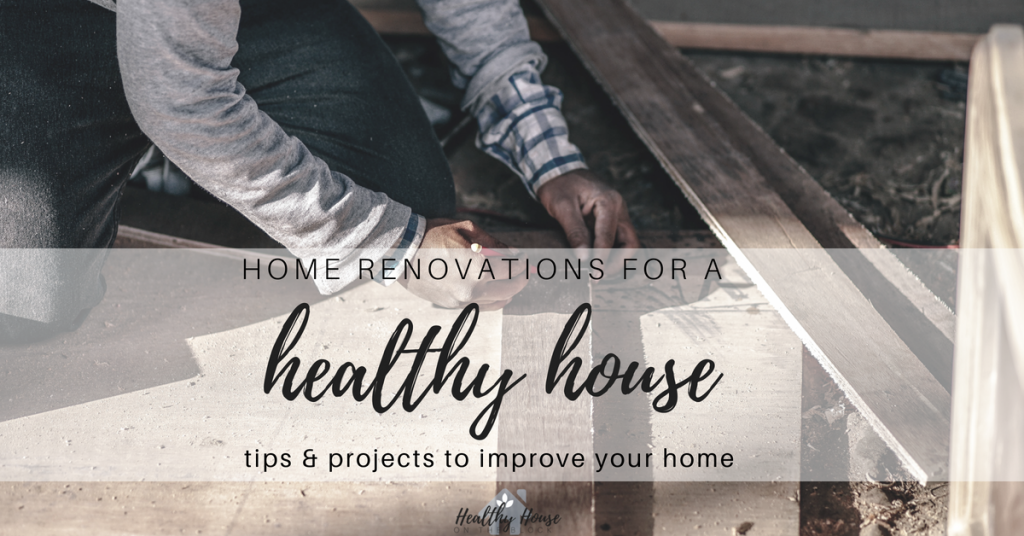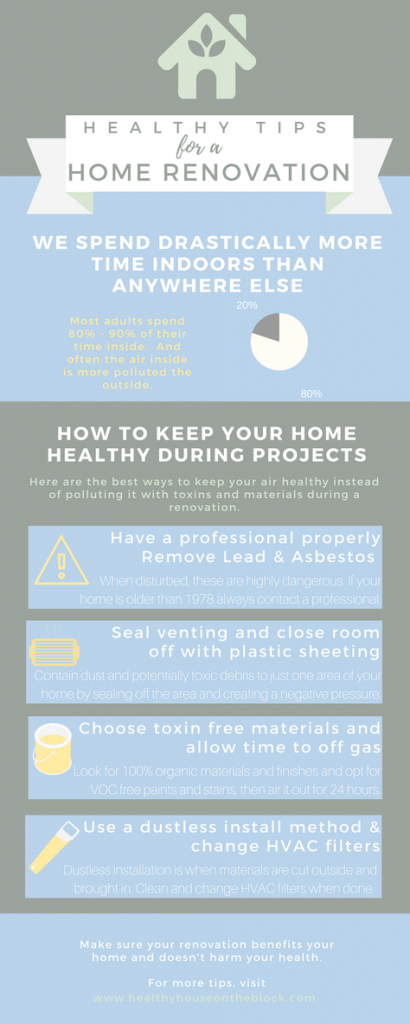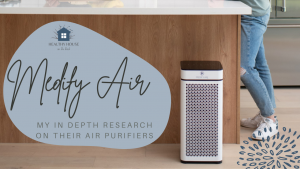
And what about the renovation itself? Do you know what projects will help create a more healthy environment in your home? Do you know just where to spend your money to make your home beneficial to your family’s health? You’ll probably be surprised to find out it’s not the most expensive projects that top the list, and in fact, their usually projects that are forgotten or labeled as unimportant. But I’m here to inform you that they are in fact VERY beneficial to your health and well-being and can make your home a truly safe and healthy environment.
The improvements paired with the other habits I teach and promote will help you create a truly healthy home that is a foundational building block to your family’s health. Remember, we want to the environment we surround ourselves with to promote health, not take away from our health. Our home is like a second skin, protecting us if we create it to do so.
1. IMPROVE VENTILATION

Moisture and humidity are a huge factor when it comes to creating a healthy home. A home with high humidity creates an environment where mold and mildew grow and where dust mites multiply. Particular rooms in the house are notorious for high humidity: Laundry, Kitchen & Bathrooms. Unfortunately many bathrooms and laundry areas are built with absolutely no windows, meaning the only option to remove moisture is through a vented fan. As a home inspector I see many bath fans that were installed when the home was built and never cleaned or changed out. The builder-grade bath fans definitely leave something to be desired.
Another issue I see when I’m inspecting a home is that the venting for the bath fan has fallen down either during a roof replacement or it was never installed correctly. This means the moisture from the room is being pulled up through the fan and vented into an enclosed attic space filled with insulation. This is an accelerated breeding ground for mold to take hold in your attic.
How to Improve your Ventilation:
- If you’ll be keeping current vented fan, I recommend cleaning it thoroughly to remove dust and build up. This helps the fan run more efficiently.
- Stick your head inside your attic to see if you can spot a vent running up through your ceiling where the fan is and out through the roof. Make sure the connections haven’t fallen down.
- If you decide to replace your vented fan, I recommend shopping for one that has a CMF rating of 110 and one that is Energy Star Rated. Click here for some of the best you can purchase.
- If your vented fan is being added to a bathroom, I recommend installing a timer switch. The timer switch will allow you to keep your fan running for at least 20 minutes after using the shower or bath.
In closet laundry rooms I highly recommend a vented fan. It’s worth your while to install one and run it while you’re doing any sort of laundry. In a kitchen, adding a hood range that is vented out of the house is also much more beneficial than a recirculating fan.
2. ADD GUTTERS
If your home is one of the many homes that doesn’t have gutters, I would urge you to explore options for adding them. Now, this is a project that can become a little more spendy, but you’ll be saving your grading and foundation from unnecessary damage.

- Check gutters for debris and clean out as much as possible. Installing a gutter guard of some sort will help with this in the future.
- Check downspouts to ensure there is no blockage and water is traveling down them unobstructed
- Check downspout extensions. They should carry water at least 4-6 feet away from your home. Water that terminates downhill is best.
3. REPLACE TOXIC CARPET

Carpet is one of the largest surface areas in many homes. Carpet often runs throughout living areas and bedrooms as well as covers basements floors. Unfortunately carpet is not only toxic in and of itself, but it also harbors organic toxins and creates and environment for them to thrive.
Synthetic carpets are often made with chemicals embedded into each fiber. This is the reason that carpets last for such a long period of time. There is also a chemical added to ensure the carpet is flame retardants, which we know is a dangerous chemical to have in our homes. The added toxin is harmful to health and has even been proven carcinogenic. In addition to the chemicals within the carpet’s fibers, many are treated with a scotchguard which protects the carpet from spills and stains.
This scotchguard is extremely harmful and has been proven to increase the cancer risk in those exposed. It’s best to avoid these chemicals if possible and if you find yourself opting for new flooring, synthetic carpet should be a last resort.
In addition to the toxins in carpet, carpet houses a plethora of biological contaminants as well. Mold and mildew quickly and easily form underneath carpet as it holds in moisture from a humid environment and leaks. Dust allergens and dust mites also quickly come into the picture when it comes to carpet. They can be very difficult to remove and get rid of completely by just vacuuming.
It’s for these reasons there are MUCH better options available when it comes to flooring. Hardwood with a non-toxic finish is an obvious choice, but some others include:
- Cork Flooring
- Bamboo Flooring
- Tile & Stone
- Organic Natural Fiber Area Rugs
- Natural, Low-Toxin Carpet with a Low-Toxin Pad
4. ADD INSULATION
Many newly built homes use foam insulation to improve energy efficiency and structure of the home. But unless your home was built in the last 2-3 years, chances are high that your home has blown in insulation in the attic and fiberglass batting in the walls. While this isn’t necessary a problem as these spaces are enclosed and often times we never come into contact with these materials, in older homes where wall cavities and attic spaces are not sealed as tightly, it can be an issue.
Fiberglass batting often times is a product that produces allergic-type reactions and can be an inviting place for mold to start growing.
- The best plan of action to take is to visually inspect the insulation in your attic to ensure it is laying as flat as possible with no mounds of insulation built in up in particular spots.
- The second place to check for insulation that may be problematic is in any unfinished spots, especially in the basement. Some homes have a layer of plastic sheeting over the insulation, which causes a barrier. Unfortunately the barrier often times collects moisture that drips down the inside of the sheeting, creating wet insulation.
The second issue with insulation is that it often isn’t doing it’s job properly, especially in older homes. Adding insulation to attics and allowing plenty of ventilation to keep the area dry and free of high levels of heat and humidity is going to be key. There are some great non-toxic insulation options that you can purchase to keep you and your family safe and healthy. Organic wool is not only a great option but is also naturally fire resistant and has actually been used for years, even in older homes. Another option is Recycled Cotton, which is often times free of any VOCs and CFS. Finally, a choice like Mineral Wool is great as it is moisture resistant as well as flame resistant. Any of these options can help improve the climate in your home as well as remove some of the toxins inside.
5. AIR TO AIR EXCHANGER
Many newer homes are built with the addition of an air to air exchanger that works to bring fresh air into the home and expel moisture and polluted air to the exterior. While older homes had many spots that air could travel into and out of the home through cracks and inefficient siding and roofing, many of those homes have since been sealed up to prevent energy loss.
This is where the problem comes in. Older homes built without an air to air exchanger that have been sealed have moisture and air pressure problems. This is why installing an air to air exchanger is so important. When a home is sealed up very tightly to prevent energy loss, but has no way of introducing fresh air, we see many problems ranging from high Radon levels due to pressure and moisture problems due to the stack effect.
Radon enters a home through cracks in the foundation flooring and through the floor drain on the lowest level. When a negative pressure is created in the house (due to a tightly sealed, energy efficient home and very little fresh air coming in) it means that air is pulled into the house through the basement cracks and floor drain. With the air comes Radon.
This could be one of the BEST ways to improve the indoor air quality within your home. It takes the humid and polluted air from inside your house and pushes it to the exterior through venting. It then pulls in fresh air from outside to replace the expelled air. When it brings fresh air inside, it pulls the air through a filter to improve the quality of the air and pull out impurities. The air exchanger also pulls out humidity from inside, which helps the indoor air quality remain at a stable and healthy level.
Now, this improvement is best installed by a professional. It can be an expensive investment, but it’s truly worth your family’s health and it’s a great benefit for resale as well.
Add Your Heading Text Here

Renovations or doing a house projects can be a messy, chaotic time. But if you’ll take the time to ensure your home remains healthy and safe, you’ll save yourself a headache in the long run. Here are some simple, easy ways to keep your home toxin free during your work:
Plastic Sheeting: While plastic isn’t ideal, it’s a great way to section off whatever area you’ll be working on to keep dust and other materials to one spot. They quickly travel throughout the house when the area is not sectioned off.
Seal Venting: Sealing any vents in the room can help prevent dust from traveling out of the area and through the venting system in your home. It can also prevent excess dust from getting into your HVAC system or furnace, which can cause it to work harder.
Change Air Filters: Be sure to replace your air filter in your HVAC system when you’re done with your project in order to prevent any of the dust from escaping your filter or blocking your filter. A blocked filter makes a fan work harder.
Dustless Method: A dustless method for installation of things like flooring means the materials are all cut outdoors and brought in only for installation. This is a great way to keep a majority of dust outside. You can even ask your contractor about this method, as some use it quite frequently while they work.
Allow Time to Off-Gas: Any new material you purchase to be installed in your home should be allowed to off gas for an ample amount of time. Anywhere from 24 hours to a week is ideal. Allow them to sit outside or in a garage area after they have been unsealed and unpackaged to allow any toxic chemicals to dissipate before bringing them inside.
GO VOC Free: When it comes to paint and stains, opt for a product that advertises VOC free. There are many more options now even compared to a few years ago when it comes to these healthier products. Still allow the proper amount of time for them to dry and the odor to dissipate before allowing kids and adults back into the space.
Toxin-Free Materials: Check the products your purchasing and the materials you’ll be adding to your home. Do a little research before your purchase to make sure your product is free from chemicals like flame retardants, perfluorochemicals and formaldehyde. There are some great resources online to find toxin-free building materials.
Check for Asbestos: If you’re home is older, it’s wise to check any area you’ll be demoing before hand to ensure there is no asbestos. Asbestos is cancer causing and when disturbed or cut into, it can cause particles to be introduced into the air. If you do detect asbestos floor tiles or other materials, it’s best to call in a professional to remove them. They should be trained to properly to safely remove and dispose of any material that is toxic.
Check for Lead: A home built before 1978 should be checked for paint with lead in it. When any wall is cut into or disturbed, it’s best to have a professional take care of the issue. They can properly remove the potential lead without contaminating the rest of the home.



